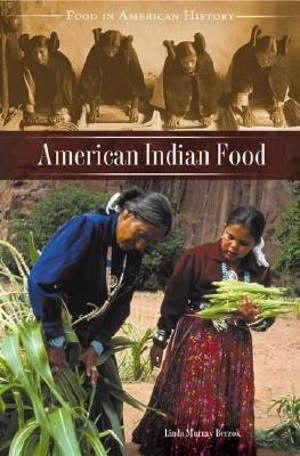by Linda Murray Berzok
From the publisher: This, the first, in-depth survey of Native American Indian foodways is an amazing chronicle of both human development over thousands of years and American history after the European invasion. It sheds light not only on this group and their history but on American food culture and history as well.
For thousands of years an intimate relationship existed between Native Americans and their food sources. Dependence on nature for subsistence gave rise to a rich spiritual tradition with rituals and feasts marking planting and harvesting seasons. The European invasion forced a radical transformation of the indigenous food habits. Foodways were one of the first layers of culture attacked. Indians were removed from their homelands, forced to cultivate European crops such as wheat and grapes, new animals were introduced, and the bison, a major staple in the Great Plains and West, was wiped out.
Today, American Indians are trying to reclaim many of their food traditions. A number of their foodways have become part of the broader American cookbook, as many dishes eaten today were derived from Native American cooking, including cornbread, clam chowder, succotash, grits, and western barbeque.
The story of Native American foodways presented here is an amazing chronicle of both human development over thousands of years and American history after the European invasion. Through cultural evolution, the First Peoples worked out what was edible or could be made edible and what foods could be combined with others, developed unique processing and preparation methods, and learned how to preserve and store foods.
An intimate relationship existed between them and their food sources. Dependence on nature for subsistence gave rise to a rich spiritual tradition with rituals and feasts marking planting and harvesting seasons. The foodways were characterized by abundance and variety. Wild plants, fish, meat, and cultivated crops were simply prepared and eaten fresh or smoked, dried, or preserved for lean winters.
The European invasion forced a radical transformation of the indigenous food habits. Foodways were one of the first layers of culture attacked. Indians were removed from their homelands, forced to cultivate European crops, such as wheat and grapes, new animals were introduced, and the bison, a major staple in the Great Plains and West, was wiped out. Today, American Indians are trying to reclaim many of their food traditions. Other traditions have become part of the broader American cookbook, as many dishes eaten today were derived from Native American cooking, including cornbread, clam chowder, succotash, grits, and western barbeque.
The scope is comprehensive, covering the six major regions, from prehistory until today. Chapters on the foodways history, foodstuffs, food preparation, preservation, and storage, food customs, food and religion, and diet and nutrition reveal the American Indians’ heritage as no history can do alone.
Examples from many individual tribes are used, and quotations from American Indians and white observers provide perspective. Recipes are provided as well, making this a truly indispensable source for student research and general readers.
Greenwood, 2005

